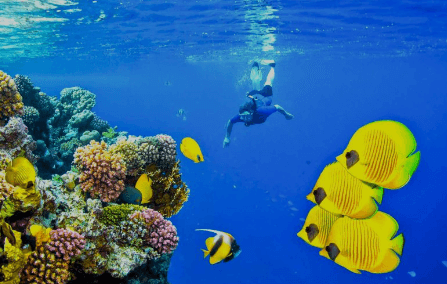
Best scuba diving in the UK 2024.
When most people think of scuba diving, they envision bright coral reefs, fascinating marine life, and balmy tropical seas. While the United Kingdom may not have the same tropical attraction as other distant paradises, it does provide a scuba diving experience that is equally, if not more, intriguing in its own right. The UK’s waters have become a destination for divers seeking adventure, discovery, and a deeper connection with the secrets of the deep, thanks to a rich maritime history, breathtaking coastal vistas, and an abundance of shipwrecks and marine species. We go on a voyage in this book to discover the hidden gems and different underwater beauties that await those who dare to dive under the surface of the United Kingdom’s oceans.
In this guide, we will go on a voyage to discover the hidden riches and different underwater delights that await those who dare to plunge under the surface of the United Kingdom’s oceans. Let’s delve into the fascinating world of scuba diving in the UK, from the rough coastlines of Scotland to the tranquil waters of Cornwall. United kingdom is home to some the best scuba dive in Europe.
What are the Best Scuba Diving Spots In The United Kingdom?
1. Scapa Flow, Orkney Islands, Scotland
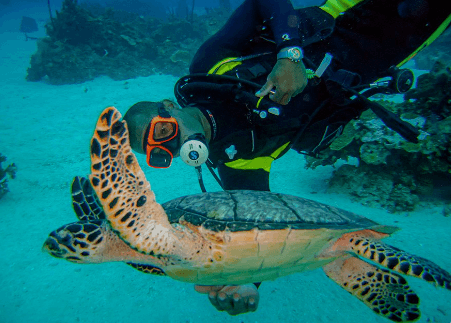
Scapa Flow, located in the Scottish Orkney Islands, is a world-renowned scuba diving location best known for its historical wreck diving. It is one of the world’s most famous wreck diving destinations, with divers able to explore well-preserved wreckage from both World Wars and one of the Best scuba diving in the UK. Here’s a more in-depth description of Scapa Flow scuba diving:
Historical Importance:
Scapa Flow is steeped in maritime history. It served as a natural harbour and anchorage for the British Royal Navy’s Grand Fleet throughout both World Wars. During these battles, the harbour was critical to naval operations.
Shipwrecks:
Scapa Flow is home to numerous historic shipwrecks, many of which are relics of the German High Seas Fleet, which was destroyed by its own men in 1919 to keep them out of British hands. Battleships, cruisers, and destroyers are among the wrecks. The SMS Kronprinz Wilhelm, SMS Karlsruhe, and SMS Coln are three famous wrecks to examine.
Conditions for Diving:
Scapa Flow has a wide range of diving conditions, with wrecks ranging in depth from shallow to deep. Visibility varies, but it is usually great, allowing divers to see the wrecks and the marine life that has made these sunken boats their home.
Water temperatures may be frigid, especially in the winter, thus divers usually wear drysuits or wetsuits.
Marine Life:
Scapa Flow wrecks have turned into artificial reefs, attracting a diverse range of marine species. Divers may come across colourful anemones, many fish species, and, on rare occasions, seals. The wrecks’ scenic attractiveness is enhanced by the marine vegetation on them.
Accessibility:
Scapa Flow diving is available to divers of all experience levels. Some wrecks are shallow and appropriate for novices, while others are deeper and may need expert or technical diving abilities.
Dive charters and operators in the region are aware and experienced with the wrecks and local circumstances, assuring a safe and pleasurable diving experience.
Dive Locations:
Scapa Flow has a variety of diving locations, each with its own personality and history. Divers may investigate the wrecks from both the outside and inside, which allows for penetration dives for those with the necessary training and expertise.
SMS Dresden, SMS Brummer, and the famed SMS Markgraf are all popular diving locations.
Dive Preparation:
Scuba diving in Scapa Flow necessitates meticulous planning. Divers must be careful of the tides, currents, and weather. The majority of dives are done from a boat, and charter companies frequently provide guided trips to the wrecks.
To guarantee safety, dive computers, dive tables, and detailed dive briefings are required.
Respect and preservation:
Divers are urged to explore the wrecks in a considerate manner that does not harm the underwater ecosystem. Many of these wrecks are battle burials of historical importance.
Taking artefacts or mementos from the wrecks is strictly banned, and divers are required to adhere to the “leave only bubbles” policy.
Scapa Flow is a bucket-list destination for scuba divers all over the world due to its unique combination of history, marine life, and different dive spots. Scapa Flow provides an extraordinary underwater experience, whether you’re an experienced wreck diver or a newbie eager to discover a piece of history under the seas.
2- Lundy Island Scuba diving England

Lundy Island, located in the Bristol Channel off the coast of North Devon, England, is a fantastic scuba diving location. Lundy Island, known for its marine biodiversity and underwater vistas, provides divers with a variety of diving opportunities. Here’s an explanation of Lundy Island scuba diving:
Marine Reserves and Protected Areas:
Lundy Island is a Marine Conservation Zone and a Marine Protected Area, which means that the seas surrounding the island are protected in order to preserve the marine ecosystem and its unique wildlife.
Water that is crystal clear:
The seas surrounding Lundy Island are recognised for their extraordinary transparency, which provides divers with great visibility. This transparency helps divers to completely enjoy the undersea world’s splendour.
Marine Life Diversity:
The seas around Lundy Island are teaming with marine life. Divers may expect to see a diverse range of creatures, including seals, dolphins, lobsters, crabs, colourful anemones, and a variety of fish. Many divers look forward to seeing seals.
Dive Locations:
Lundy Island has a variety of diving locations, each with its own distinct qualities. Popular web pages include:
Lundy Walls:
These underwater cliffs are home to a plethora of marine life, including sponges and corals. Divers can investigate gullies and crevices that are home to a variety of animals.
Severns Rocks:
This place is known for its diverse biodiversity and is frequently visited by playful seals and massive underwater rock formations.
The Bay of Gannets:
This location allows visitors to see seals and numerous fish types. It’s a popular location for underwater photographers.
The Wreck of the Iona II:
Divers may explore this wreck, which offers a look into maritime history. It is home to a wide variety of aquatic species.
Conditions for Diving:
Lundy Island has a variety of diving conditions to accommodate divers of all skill levels. The depths fluctuate, making it suitable for both novice and expert divers.
Water temperatures in the summer can be quite mild, however drysuits or heavy wetsuits are required to keep comfortable because temperatures can still be cold.
Dive Operators:
Dive operators and charter boats may be found on Lundy Island and in adjacent coastal communities. To guarantee a safe and fun diving experience, these companies provide guided dives, equipment rental, and local expertise.
Accommodation and transportation:
Camping and self-catering accommodations are available on Lundy Island. Because access to the island is normally via boat from the mainland, it is critical to schedule your stay and diving expeditions ahead of time.
Diving at Lundy Island provides a once-in-a-lifetime opportunity to experience a pristine and protected aquatic habitat. Lundy Island is a prominent diving site in the United Kingdom that caters to divers of all interests and experience levels, whether you’re interested in underwater photography, encountering seals, or simply enjoying the tranquilly of clear waters.
3- St. Abbs and Eyemouth, Scotland
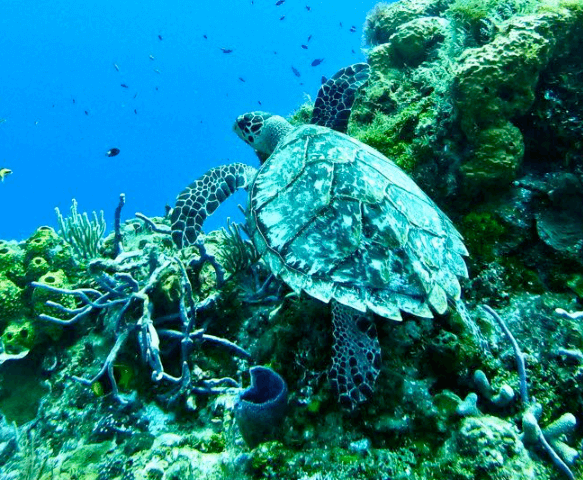
St. Abbs and Eyemouth, on Scotland’s southeastern coast, are well-known scuba diving destinations for their spectacular underwater landscapes, marine life, and rich underwater heritage. Here’s a more in-depth look at scuba diving at St. Abbs and Eyemouth:
Overview and Location:
St. Abbs is a scenic fishing community and nature reserve, and Eyemouth is a neighbouring town, both located along Scotland’s craggy coast in Berwickshire.
These coastal locations are famous among divers due to their unusual combination of underwater landscape, pure seas, and rich marine life.
Marine Life:
St. Abbs and Eyemouth are well-known for their diverse marine life. Divers may expect to see a variety of species such as colourful anemones, crabs, lobsters, several fish types, and marine invertebrates.
Grey seals are frequently spotted when diving, and underwater photographers frequently discover wonderful subjects among the rich marine life.
Dive Locations:
- There are various diving sites in the vicinity, each with its own distinct characteristics:
Cathedral Rock: Named after its impressive rock formations, this location allows visitors to explore gullies and crevices teeming with marine life. - Skellies: This place is known for its underwater pinnacles and walls and offers opportunity to observe lobsters and crabs.
- Green Ends Gully: A popular diving spot with an underwater gorge and a plenty of marine life.
- Wuddy Rocks: A location featuring rocky reefs and cliffs.
Divers will like how many diving locations are accessible from the beach. Others may require a boat to reach deeper and more inaccessible areas.
Conditions for Diving:
The seas of St. Abbs and Eyemouth have typically high visibility, especially in the summer. Visibility can range between 10 and 30 metres (33 and 98 ft), allowing for good views of the aquatic environment.
Water temperatures can fluctuate, with June and September being the hottest months. Divers often wear drysuits or bulky wetsuits to keep warm all year.
Dive Operators:
Dive shops and operators in St. Abbs and Eyemouth provide services like as equipment rental, guided dives, and local knowledge. These operators can offer important advice on the best diving spots according on your level of expertise and interests.
Dive Training:
There are alternatives for scuba instruction in the region if you are a novice or seeking to develop your diving abilities. There are diving classes available to assist you enhance your underwater abilities and confidence.
Accommodation and transportation:
Hotels, bed-and-breakfasts, and self-catering cottages are available in St. Abbs, Eyemouth, and the surrounding districts.
St. Abbs and Eyemouth are both easily accessible by car and around an hour’s drive from Edinburgh, making them ideal for divers coming from the capital.
Diving at St. Abbs and Eyemouth allows you to discover the enthralling underwater world of Scotland’s southeastern coast. The area’s clean waters, colourful marine life, and underwater vistas make it a must-visit location for those wishing to immerse themselves in the splendour of the North Sea, whether you’re a seasoned diver or a beginner.
4- Farne Islands Scuba Diving, England

The Farne Islands, off the coast of Northumberland in northern England, are a well-known scuba diving destination famed for its breathtaking underwater vistas, diverse marine life, and one-of-a-kind encounters with grey seals. Here’s a more in-depth look at scuba diving in the Farne Islands:
Overview and Location:
The Farne Islands are a collection of rocky islands, each with its own set of underwater characteristics. Because these islands are part of a marine reserve, they are a paradise for divers and wildlife aficionados alike.
The Grey Seals:
The possibility to engage with grey seals (Halichoerus grypus) is one of the main draws of diving in the Farne Islands. These curious and playful marine creatures have been known to approach divers, providing unique underwater experiences.
Many divers consider diving with seals to be a highlight because of their quickness and curiosity. Underwater photographers frequently visit the Farne Islands to catch these beautiful critters on film.
Dive Locations:
The Farne Islands have a number of diving locations, each with its own distinct characteristics:
- Seal Cove: As the name implies, this location is known for seal encounters. Divers may engage with seals in their natural environment and see their playful behaviours.
- Blue Caps: This place is well-known for its underwater rock formations and colourful marine life. It also has a diversified underwater terrain.
- Swadger’s Hole: This location has impressive underwater gullies and cliffs, allowing visitors to explore nooks and overhangs teeming with marine life.
- North Wamses is a place with big stones and cliffs that are filled with marine life such as crabs, lobsters, and many fish species.
The majority of diving spots are accessible by boat, and professional dive companies provide guided trips and equipment rentals.
Conditions for Diving:
The Farne Islands are typically acceptable for divers of all levels of expertise, from beginners to advanced. Depths can range from shallow to deep, enabling a variety of skill levels.
The temperature of the water changes with the seasons. To keep comfortable in the chilly waters, drysuits or heavy wetsuits are advised.
Dive Operators:
In the adjacent hamlet of Seahouses, several diving businesses provide services such as guided dives, equipment rental, and boat charters. These operators are well-versed in the finest diving spots and local weather conditions.
Respect and conservation:
The Farne Islands are a marine reserve that emphasises the necessity of safe diving practises. Divers are advised to obey environmental rules, including as avoiding contact with seals and not disrupting the underwater ecosystem.
Accommodation and transportation:
Seahouses is the major gateway to the Farne Islands, and it has a variety of lodging alternatives, including hotels, guesthouses, and self-catering cottages.
The Farne Islands may be reached by boat from Seahouses, and several diving companies offer transportation to and from the islands.
Dive trips to the Farne Islands provide an outstanding opportunity to immerse yourself in the grandeur of the North Sea while interacting with curious grey seals. The Farne Islands provide a remarkable underwater trip in the midst of Northumberland’s coastline splendour, whether you’re a nature enthusiast, underwater photographer, or simply looking for a unique diving experience.
5-Plymouth Scuba diving England
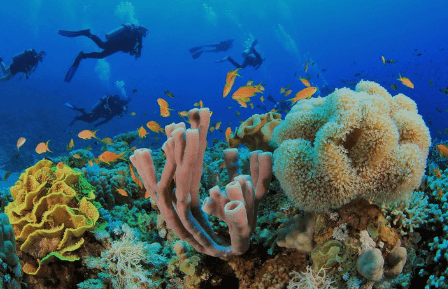
Plymouth, on England’s southwestern coast, is a bustling and historical city that also serves as a popular entrance to some of the greatest scuba diving in the UK. Plymouth’s seas are famous for their rich maritime history and number of shipwrecks, making it an excellent scuba diving location. Here’s a more in-depth look into scuba diving in Plymouth, England:
Historical Importance:
Plymouth has a long nautical history, and its waterways have seen countless naval fights and shipwrecks. Divers may discover a plethora of underwater heritage as a result of this past.
Shipwrecks:
Plymouth’s shoreline is littered with shipwrecks, some of which may be reached by divers. Many of these wrecks originate from different historical periods, including both World Wars and previous periods. Among the notable wrecks are:
- HMS Scylla: This decommissioned Royal Navy ship was deliberately destroyed in order to construct an artificial reef. It’s one of the UK’s most popular and conveniently accessible wreck dives.
- James Eagan Layne: A World War II wreck with marine life and unique characteristics that provides a superb diving experience.
- M2 Submarine: An interesting diving site that features the wreckage of a British submarine that sank during a test dive in 1932.
Conditions for Diving:
Plymouth has a wide range of diving conditions suited for divers of all skill levels. Some of the wrecks are in shallower waters, making them suitable for novices, while others are deeper and better suited to expert or technical divers.
Water temperatures fluctuate throughout the year, with June and September being the hottest months. To remain warm in the colder waters, drysuits or bulky wetsuits are generally used.
Marine Life:
The underwater ecosystem of Plymouth is filled with marine life. Divers may come across a variety of creatures such as crabs, lobsters, numerous fish, and colourful marine invertebrates. Diverse groups of aquatic creatures frequently inhabit wrecks.
Dive Operators:
Plymouth is home to a number of diving shops and operators that provide guided dives, equipment rental, and local expertise. These experts are well-versed in the area’s wrecks and diving conditions.
Dive Instruction:
Whether you’re a novice or an experienced diver eager to discover new wrecks, Plymouth has scuba training options. There are diving courses available to assist you improve your abilities and safety knowledge.
Accommodation and transportation:
Plymouth has a variety of lodging alternatives, such as hotels, guesthouses, and self-catering flats. The city is conveniently accessible by road and train from all regions of the United Kingdom.
Plymouth diving offers an interesting mix of history, marine exploration, and underwater adventure. Whether you’re a wreck diver, a history buff, or simply looking for a new adventure.
6- Swanage Scuba Diving England.

Swanage, a gorgeous seaside village in Dorset, England, provides divers with a one-of-a-kind and gratifying scuba diving experience. Swanage’s waters are noted for their rich marine life, underwater sceneries, and a range of dive locations ideal for divers of all skill levels. Here’s a more in-depth look into scuba diving in Swanage, England:
Overview and Location:
Swanage is located along the Jurassic Coast, which is a UNESCO World Heritage site recognised for its geological significance and natural beauty. The town provides as a gateway to some of the most exciting diving spots in the UK.
Dive Locations:
Swanage has a variety of diving locations, each with its own distinct characteristics:
- Swanage Pier: This landmark spot is great for beginners and training dives. It’s alive with marine life, such as crabs, fish, and bright anemones. Swanage Pier’s night dives are very popular.
- Peveril Ledges: A rocky reef famous for its breathtaking underwater geology, which includes gullies, overhangs, and tunnels. Divers may see a variety of marine animals here.
- Kimmeridge Bay: This adjacent location is famous for its rocky ledges and underwater nooks. It is a haven for a wide variety of marine life, including nudibranchs and other invertebrates.
- Balaclava Bay is a great place to explore underwater caverns, tunnels, and swim-throughs. Divers are frequently able to discover lobsters and other crustaceans hidden in fissures.
Many of these locations are easily accessible from the shore, making them ideal for divers. Boat dives to more remote sites are also possible.
Marine Life:
Swanage’s seas are teeming with marine life. Divers may expect to see crabs, lobsters, cuttlefish, seahorses, and a variety of fish species. Colourful sponges, anemones, and other invertebrates are common among the rich marine life.
Conditions for Diving:
Swanage diving conditions are typically adequate for divers of all levels of expertise. The depths vary across dive locations, providing chances for both novice and expert divers.
Water temperatures can fluctuate, with the hottest months being June through September. To remain warm in the colder waters, divers often wear drysuits or bulky wetsuits.
Dive Operators:
Dive shops and operators in Swanage offer services such as guided dives, equipment rental, and local expertise. These personnel are knowledgeable about the greatest dive spots and can help divers organise their underwater experiences.
Accommodation and transportation:
Swanage has a variety of lodging alternatives, such as hotels, bed-and-breakfasts, and self-catering cottages. It’s easily accessible by car and a popular stop for tourists touring the Jurassic Coast.
Diving at Swanage allows you to discover the Jurassic Coast’s magnificent underwater scenery and diverse marine life. Swanage’s coastal waters provide a fascinating and enriching scuba diving experience, whether you’re a beginning diver hoping to discover the beauty of the underwater world or an experienced diver searching for new experiences.
7- Isle of Man Scuba Diving

The Isle of Man, nestled between England and Ireland in the Irish Sea, is a lesser-known yet compelling scuba diving location. Divers may enjoy gorgeous coastline diving, rich marine life, and the opportunity to explore underwater shipwrecks in this self-governing British Crown Dependency. Here’s a more in-depth look at scuba diving in the Isle of Man:
Overview and Location:
The craggy coastline of the Isle of Man, along with a plethora of underwater attractions, has made it an increasingly popular destination for divers searching for unique experiences.
Dive Locations:
The Isle of Man has a number of diving locations, each with its own distinct characteristics:
Sugarloaf Caves:
A famous diving destination recognised for its spectacular underwater tunnels and caverns. Divers may explore these underground structures and come face to face with aquatic life.
Port Erin:
This location has a combination of rocky reefs and sandy seabeds. Divers may see a variety of marine life, such as dogfish, lobsters, and anemones.
Burroo Ned:
Burroo Ned is a popular destination for macro photographers due to its numerous marine creatures and colourful underwater sceneries.
SS Karlsruhe:
This World War II wreck, which lies in roughly 40 metres (131 feet) of water, is one of the most well-known on the Isle of Man. It is well-known for its historical significance as well as its marine life.
Marine Life:
Seals, basking sharks, dogfish, cuttlefish, nudibranchs, and anemones may all be found in the seas surrounding the Isle of Man. The presence of kelp forests and rocky reefs improves the area’s biodiversity.
Conditions for Diving:
Divers of all ability levels may enjoy the diving conditions surrounding the Isle of Man. The depths can vary across dive sites, making them suitable for both novices and experienced divers.
Water temperatures are often chilly, and divers frequently wear drysuits or bulky wetsuits all year.
Dive Operators:
On the Isle of Man, dive shops and operators offer services such as guided dives, equipment rental, and local expertise. These professionals have prior expertise visiting local diving locations.
Respect and conservation:
To conserve the maritime ecosystem surrounding the Isle of Man, responsible diving practises are required. Divers should follow criteria to ensure they have the least possible influence on underwater habitats.
Accommodation and transportation:
The Isle of Man has a variety of lodging alternatives, such as hotels, guesthouses, and self-catering cottages. The island is primarily accessed by ferry or plane, with frequent links to the mainland.
Divers in the Isle of Man have the opportunity to explore a less busy and largely unexplored underwater environment. Whether you want to explore caverns, see marine life, or find historical wrecks, the Isle of Man offers a unique and fascinating scuba diving experience in the midst of the Irish Sea.
8-Pembrokeshire Scuba diving Wales

Pembrokeshire, in southwestern Wales, is a compelling scuba diving destination noted for its rocky coasts, abundant marine life, and an abundance of underwater activities. Here’s a more in-depth look at scuba diving in Pembrokeshire, Wales:
Overview and Location:
Pembrokeshire is known for its beautiful coastline, which is part of the Pembrokeshire Coast National Park, the UK’s only coastal national park. The park’s beautiful waters provide a plenty of diving possibilities.
Dive Locations:
Pembrokeshire has a variety of diving locations with distinct characteristics:
- Stack Rocks: This diving location is well-known for its underwater pinnacles and stunning rock formations. Colourful anemones and a diversity of fish species are among the marine life.
- Skomer Island: Known for its seal population and underwater kelp forests, this marine nature reserve is a must-see. Divers frequently come with playful seals and explore vivid underwater sceneries.
- The Smalls: This location, located further offshore, is noted for its difficult circumstances and deep dives. Divers may explore the area’s cliffs, pinnacles, and rich marine life.
- St. Govan’s Head: This location is famous for its underwater caves, caverns, and tunnels. It provides exceptional cave diving and underwater exploring options.
Marine Life:
The seas of Pembrokeshire are rich with marine species. Divers may come across seals, dolphins, porpoises, lobsters, crabs, different fish types, and a variety of colourful marine invertebrates.
Conditions for Diving:
Pembrokeshire diving conditions are ideal for divers of all ability levels. The depths vary across dive sites, making them suitable for both novice and expert divers.
Water temperatures fluctuate with the seasons, but drysuits or heavy wetsuits are commonly used to remain warm in colder waters.
Accommodation and transportation:
Pembrokeshire has a variety of lodging alternatives, such as hotels, bed-and-breakfasts, and self-catering cottages. The region is well-connected by road to the rest of Wales and the United Kingdom.
Divers may experience the spectacular underwater landscapes and colourful marine life of Pembrokeshire, Wales, through diving. Whether you want to see seals, explore underwater caverns, or simply relax in calm seas, Pembrokeshire offers a wonderful and enriching scuba diving experience along the Welsh coast.
9- Sound of Mull, Scotland scuba diving
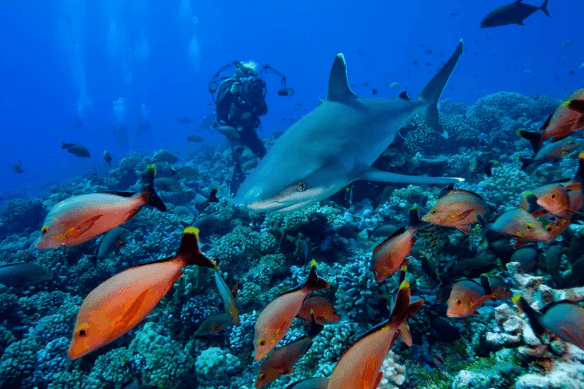
The Sound of Mull, located off Scotland’s western coast, is a world-class scuba diving site famed for its deep wrecks, magnificent underwater landscape, and abundant marine life. Here’s a more in-depth look at scuba diving in the Sound of Mull:
Overview and Location:
The Sound of Mull is a short waterway that connects the Isle of Mull to the Scottish mainland. It is part of the Inner Hebrides, a region famed for its rocky scenery, pristine seas, and good diving.
Shipwrecks
The Sound of Mull is famous for its deep wrecks that draw divers from all over the world. Among the most well-known wreck dives in the region are:
- HMS Dartmouth: A World War I cruiser that sits in deep water and is popular among technical divers.
- Rondo: A World War II German freight ship that lies at a depth appropriate for expert divers.
- Shuna: Another WWII wreck with fascinating marine life and underwater characteristics.
- The SS Hispania is a shallow wreck in Tobermory that is perfect for leisure and training dives.
Dive Locations:
The Sound of Mull has a diverse assortment of diving locations, each with its own distinct characteristics:
- Cathedral Rock is well-known for its stunning rock formations and underwater arches.
- Rubha Nan Sith: A strong current drift dive where divers may see a variety of fish species.
- Loch Sunart: A protected location with a variety of shallow and deep diving spots, as well as cliffs and caves.
- Tobermory Bay: The bay has a variety of diving locations ranging from shallow to deep, as well as the colourful wreck of the SS Hispania.
Conditions for Diving:
The diving conditions in the Sound of Mull differ depending on where you go. Some dives are appropriate for novices, while others, particularly deep wrecks, need expert or technical diving abilities.
Visibility may be great, especially during the summer months, allowing divers to see the underwater environment well.
Marine Life:
The marine biodiversity is abundant in the Sound of Mull. Divers may come across a variety of animals, including as dogfish, conger eels, lobsters, crabs, and a plethora of colourful anemones. Diverse groups of aquatic creatures frequently inhabit wrecks.
10- Isle of Scilly England Scuba diving
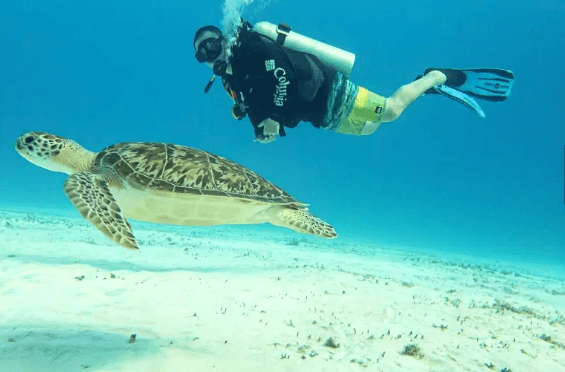
The Isles of Scilly, an archipelago off the southwest coast of Cornwall, England, is a beautiful and intriguing scuba diving location. The Isles of Scilly, known for their crystal-clear seas, rich marine life, and interesting shipwrecks, provide a one-of-a-kind underwater experience. Here’s a more in-depth look at scuba diving in the Isles of Scilly:
Overview and Location:
The Isles of Scilly are a collection of islands and islets surrounded by clean, unpolluted seas, making it a perfect destination for divers wishing to explore a pristine marine environment.
Dive Locations:
The Isles of Scilly include a range of diving locations, each with its own distinct characteristics:
- Bishop Rock: This location is home to the Bishop Rock Lighthouse and boasts stunning underwater cliffs, gullies, and the possibility of encountering seals.
- The Eastern Isles: These rocky islets are home to a wide diversity of marine life, including colourful anemones, sponges, and a range of fish species.
The Gweal and Annet Wrecks:
These 17th and 18th century shipwrecks provide a peek into nautical history and attract marine life.
The Runnel Stone: A pinnacle diving site notable for its underwater topography and interactions with bigger marine creatures such as basking sharks and dolphins.
Marine Life:
A diverse assortment of marine life lives in the clean and nutrient-rich seas surrounding the Isles of Scilly. Divers may expect to see seals, dolphins, basking sharks, lobsters, crabs, cuttlefish, and other fish species.
Dive Conditions:
The diving conditions on the Isles of Scilly are typically appropriate for divers of all ability levels. The depths vary across dive sites, making them suitable for both novice and expert divers.
Water clarity allows for amazing underwater photos when visibility is good.
Respect and conservation:
To conserve the marine environment in the Isles of Scilly, responsible diving practises are required. Divers should adhere to criteria that encourage the preservation of underwater habitats and the preservation of historical wrecks.
Accommodation and transportation:
Accommodation choices on the Isles of Scilly include hotels, guesthouses, and self-catering cottages. The islands are normally reached by ferry or aircraft, with regular links to the mainland.
Diving in the Isles of Scilly offers a once-in-a-lifetime opportunity to experience a pristine marine environment.
FAQs About Best Scuba Diving in the UK.
Is scuba diving widely practised in the United Kingdom?
Scuba diving is a popular leisure sport in the United Kingdom. The country’s numerous diving sites, ranging from shipwrecks to marine reserves, make it appealing to both domestic and foreign divers.
What are some popular scuba diving locations in the United Kingdom?
The Farne Islands, St. Abbs and Eyemouth, Scapa Flow in Orkney, Lundy Island, and Plymouth are all popular scuba diving sites in the UK.
What is the water temperature for scuba diving in the United Kingdom?
Water temperatures in the United Kingdom change with the seasons. They are usually the chilly in the winter (about 7-12°C or 45-54°F) and the hottest in the summer (approximately 15-20°C or 59-68°F). Divers frequently wear drysuits or bulky wetsuits to keep warm.
What marine life might I expect to observe while scuba diving in the United Kingdom?
Seals, dolphins, lobsters, crabs, numerous fish species, colourful anemones, sponges, and other marine life may be found in UK seas.
Is there a diving shop in the UK that provides guided dives and equipment rental?
Yes, there are various diving shops and operators located around the United Kingdom that offer services such as guided dives, equipment rental, and dive instruction.
Can I dive as a novice in the UK, or is it just for experienced divers?
The United Kingdom has a diverse assortment of diving sites ideal for divers of all skill levels, including beginners. Many dive sites feature shallow regions with calm conditions that are good for beginners, while others have deeper and more difficult dives for experienced divers.
What are the ideal months to go scuba diving in the United Kingdom?
In the UK, the ideal months for scuba diving are often late spring (May) through early fall (September), when water temperatures are somewhat warmer and visibility is higher.
Are there any scuba diving limits or rules in the UK?
Divers should be mindful of local laws and marine conservation requirements, especially while diving in designated protected zones. To safeguard the marine ecosystem, it is important to practise responsible diving.
Do I need any specific qualifications to dive in the United Kingdom?
While basic open water certification is enough for many dive locations, more difficult or deep dives may need advanced or technical diving certificates. Check the exact criteria for your preferred diving destinations.
Is it possible to dive on shipwrecks in the United Kingdom?
Yes, the United Kingdom is well-known for its shipwrecks, many of which are accessible to divers. Diving on historical wrecks is a popular hobby, but divers must be properly trained and experienced.
Is there any diving in marine protected zones or reserves in the UK?
Yes, the United Kingdom has various marine protected zones (MPAs) and marine reserves popular with divers. These areas have been established to protect marine biodiversity and frequently provide outstanding diving opportunities.
What sorts of dive equipment are required for diving in the United Kingdom?
A mask, snorkel, fins, wetsuit or drysuit, buoyancy control device (BCD), regulator, tank, and dive computer are all required for UK diving. Depending on the water temperature and diving circumstances, additional gear such as gloves, hoods, and dive lights may be required.
Is it possible to dive all year in the UK, or are there special diving seasons?
Although diving is feasible all year, many divers choose the warmer months of spring through early October for more pleasant circumstances. Some dive locations, particularly those in cooler waters, may be more difficult to visit during the winter.
Is there anything special to consider when diving in the UK, such as currents or tides?
Yes, divers should be wary of strong tidal currents in some spots. It is critical for safe diving to check tide tables and understand local currents. Furthermore, dive preparation should take into consideration any changes in meteorological conditions.
Can I see sharks when scuba diving in the United Kingdom?
While shark encounters are less common in the UK than in tropical dive locations, numerous shark species, including dogfish and basking sharks, can be observed in UK waters during specific seasons.
Related:






